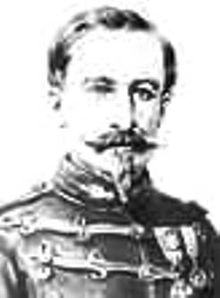De Bange
| Charles Ragon de Bange | |
|---|---|

de Bange.
|
|
| Born | 1833 |
| Died | 1914 |
| Allegiance |
France |
| Service/branch | French Army (Artillery) |
| Rank | Colonel |
Charles Ragon de Bange (1833–1914) was a Polytechnician and a French artillery colonel of the 19th century. He invented the first effective obturator system for breech-loading artillery. Its basic principle of functioning is still widely in use to this day. He also designed a system of field guns of various calibers which served the French Army well into World War I: the Système de Bange.
Many attempts had been made at developing breech-loading cannons, but had only partial success sealing of the breech. When fired, hot gasses and burning gunpowder could escape, losing power and potentially burning the operating crew. Rifles, with smaller loads and thus less stress, were able to use rubber in O-rings as on the Chassepot rifle. The same principle of breech sealing applied on cannons was not as easy to develop . Several materials were able to hold the pressure and heat of cannon fire, but did not expand like rubber, thereby failing to provide a tight seal.
However, in 1872, de Bange successfully designed the De Bange system, a new type of obturator for cannons. His system used a breech block made of three parts; an interrupted screw locking mechanism at the rear, a doughnut-shaped grease-impregnated asbestos pad that sealed the breech, and a rounded movable "nose cone" at the front. When the gun fired, the nose was driven rearward, compressing the asbestos pad and squeezing it so it expanded outward to seal the breech. The French referred to the shape of the breech's nose as "mushroom like", as it resembled the cap of a mushroom.
The action was controlled by a handle, normally mounted vertically on the right side of the breech. When lifted, the handle operated a cam that forced the breech to rotate counter-clockwise, unlocking the interrupted thread. The entire breech was then pulled rearward with the same handle, sliding on a ring-shaped holder. The breech holder was hinged on one side, normally the left, so when the breech block was slid all the way to the rear it could be rotated out of the way for loading.
The de Bange system was widely adopted, including by the United States Navy and the British Royal Navy. The technique developed by de Bange is still in use today.
...
Wikipedia
